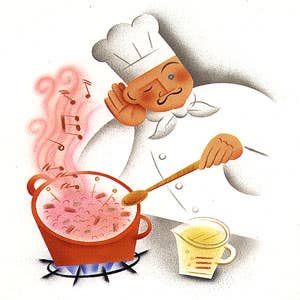
Risotto Voce
''You cook risotto by ear,'' begins Cesare Benelli, the handsome, mustachioed chef-owner of the celebrated Ristorante Al Covo in Venice. I'm paying him a visit on business, researching my book Mediterranean Grains & Greens (to be published this August by HarperCollins). Benelli speaks English very well—his wife is from Texas—and cooks even better. Especially risotto: pumpkin risotto with wild duck ragout, wild greens risotto with hops shoots...and ''butcher's choice'' risotto, a Venetian classic, so named (Benelli explains) because ''you want to use what the Venetians call secole, the juicy meat around the ribs and spine—the very part the butcher keeps for himself.''
Risotto, according to Benelli, is auditory, and one need only pay attention to the symphony of sounds signaling different stages in the cooking process to guarantee success. To demonstrate, he starts by making a risotto base, sauteing shallots and garlic in olive oil. Once the sizzling has subsided, he adds all the rice at once. (''Calculate the traditional way,'' he suggests, ''one handful per person.'') Flavor, he notes, is best coaxed out of the rice by toasting—not browning, which seals the grain, impeding its ability to soak up liquid in later steps. ''The rice will whistle when it's time to scrape whatever is stuck on the bottom of the pan,'' he says. ''This is the moment to deglaze, to shock the rice with cold wine—it must be cold. Let it evaporate completely.'' I hear a crackling sound as the rice starts to open and to release its starch. At this point, he begins to pour in the warm broth slowly, in increments—always just enough to cover the rice.
''Don't let the rice get dry,'' he says. ''Keep it 'loose' during the simmering so that it opens up slowly, simultaneously releasing its starches and absorbing the broth.'' Periodically Benelli grips the skillet firmly and shakes it back and forth—I hear swishing—so that the starches from the rice can bind with the reduced flavors from the broth. Stirring, he warns, will smash the grains of rice. ''The rice is ready when it has a creamy consistency.'' He adds oil and cheese, lets it sit for a couple minutes, then plates a wavy risotto. The rice, cloaked in a rich sauce, is cooked, but each grain is still firm at its core. It is a perfect risotto, a grand finale.
Keep Reading
Continue to Next Story










